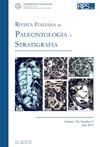PERMIAN NON-MARINE BIVALVES FROM THE COLLIO AND GUNCINA FORMATIONS (SOUTHERN ALPS, ITALY): REVISED BIOSTRATIGRAPHY AND PALAEOBIOGEOGRAPHY
IF 1.9
3区 地球科学
Q2 GEOLOGY
引用次数: 0
Abstract
Non-marine bivalves are key fossils in Permian continental stratigraphy and palaeogeography. Although known since the end of 19th century, the occurrences from the continental basins of the Southern Alps have never been extensively studied. The non-marine bivalves from the Lower Permian Collio Formation (Brescian pre-Alps) are herein revised, and those from the Guncina Formation (Athesian District) are described for the first time. These two units yielded non-marine bivalves belonging to the genus Palaeomutela sensu lato, which is widespread in the Permian continental successions of eastern Euramerica. Three Palaeomutela morphotypes have been herein described: oval-subtriangular, subtrapezoidal and elongated. The latter includes several specimens herein assigned to Palaeomutela (Palaeanodonta) berrutii sp. nov. and dominates the Collio Formation association. The Guncina Formation yielded also the genus Redikorella, for the first time co-occurring on the same stratigraphic horizon of Palaeomutela, herein assigned to Palaeomutela (Palaeanodonta) guncinaensis sp. nov. To-date, it was generally accepted that the first members of the genera Palaeomutela and Redikorella occurred during the Ufimian (late Kungurian of the global scale) in the non-marine basins of the Cis-Ural Foredeep and of Angara, respectively. Such new finds in the early-middle Kungurian of southwestern Europe, well constrained by radioisotopic dating, suggest new global first appearance (First Appearance Datum) and a possible new center of origin of these genera. This fact raises new questions on biostratigraphy, palaeobiogeography and palaeoecology, which will require further research. If we assume that the genera Palaeomutela and Redikorella had only one center of origin, we need to hypothesise possible migration routes from SW Europe to the continental basins of Eastern Europe and Angara. Apparently, such migration could be better supported by a Pangaea B palaeogeographic configuration.意大利南阿尔卑斯山脉碰撞组和guncina组的二叠纪非海相双壳类:订正生物地层学和古生物地理学
非海相双壳类是二叠纪陆相地层学和古地理的重要化石。虽然从19世纪末就知道了,但从南阿尔卑斯山的大陆盆地发生的事件从未被广泛研究过。本文对下二叠统科利奥组(Brescian pre-Alps)的非海相双壳类进行了修订,并首次描述了Guncina组(Athesian District)的非海相双壳类。这两个单元产出的非海生双壳类动物属于Palaeomutela sensu lato属,广泛存在于东欧美洲的二叠纪大陆序列中。本文描述了三种古毛藻形态:卵形-近三角形,近梯形和细长型。后者包括本文中归属于Palaeomutela (Palaeanodonta) berrutii sp. nov.的几个标本,在科利奥组群中占主导地位。Guncina组还发现了Redikorella属,这是该属首次在Palaeomutela (Palaeanodonta) guncinaensis sp. 11的同一地层层位上同时出现,目前普遍认为,该属和Redikorella属的第一批成员分别出现在乌米期(全球尺度的昆古里期晚期),分别出现在csis - ural前深和Angara的非海相盆地。这些在欧洲西南部昆古里亚早期中期的新发现,受到放射性同位素测年的良好约束,表明这些属可能是新的全球首次出现(首次出现基准点)和新的起源中心。这一事实对生物地层学、古生物地理学和古生态学提出了新的问题,需要进一步研究。如果我们假设古omutela属和Redikorella属只有一个起源中心,我们需要假设从欧洲西南部到东欧和安加拉大陆盆地的可能迁移路线。显然,这种迁移可以更好地支持泛大陆B古地理配置。
本文章由计算机程序翻译,如有差异,请以英文原文为准。
求助全文
约1分钟内获得全文
求助全文
来源期刊
CiteScore
3.60
自引率
4.30%
发文量
28
审稿时长
>12 weeks
期刊介绍:
The Rivista Italiana di Paleontologia e Stratigrafia was founded in 1895. It publishes original papers dealing with all fields of paleontology and of stratigraphy, from Italy and the Mediterranean to the Tethys, as well across the globe from China to North America.

 求助内容:
求助内容: 应助结果提醒方式:
应助结果提醒方式:


